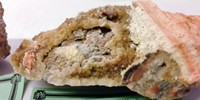Advertisement
Grab your lab coat. Let's get started
Welcome!
Welcome!
Create an account below to get 6 C&EN articles per month, receive newsletters and more - all free.
It seems this is your first time logging in online. Please enter the following information to continue.
As an ACS member you automatically get access to this site. All we need is few more details to create your reading experience.
Not you? Sign in with a different account.
Not you? Sign in with a different account.
ERROR 1
ERROR 1
ERROR 2
ERROR 2
ERROR 2
ERROR 2
ERROR 2
Password and Confirm password must match.
If you have an ACS member number, please enter it here so we can link this account to your membership. (optional)
ERROR 2
ACS values your privacy. By submitting your information, you are gaining access to C&EN and subscribing to our weekly newsletter. We use the information you provide to make your reading experience better, and we will never sell your data to third party members.
Environment
Plastic Plumbing Can Make Water Nasty
New research reveals which pipes give drinking water odd tastes and odors
by Bethany Halford
August 24, 2007

Does your drinking water have an odd bouquet? Does it taste as though it's been sitting outside in a rubber tire? If so, said Andrea M. Dietrich, a civil and environmental engineering professor at Virginia Polytechnic Institute & State University, your plumbing may be to blame.??
As plastic has started to replace metal as the material of choice for water pipes, complaints about drinking-water quality have been on the rise. "Utilities sometimes get calls from customers that their water tastes or smells different," said Gary A. Burlingame, a water-quality scientist at the Philadelphia Water Department. "When the utility investigates, the source of the problem is not found to be the utility's water, but the customer's plumbing." However, he added, "the nation's long-term experience with plastic pipe is lacking, and there is a need for better guidance on the use and application of different plastic materials."
That's where Dietrich's research comes in. To determine which pipes are the worst culprits, she has been studying how different plumbing materials affect the odor and taste of drinking water. She presented her findings this week in the Division of Polymer Chemistry at the ACS national meeting in Boston.
Dietrich and her research team took commercially available plastic pipes and filled them with purified water that they had treated with the natural minerals and disinfectants usually found in drinking water. They let the water sit in the pipes for three days and then subjected it to both instrumental analysis and a panel of sensory experts who evaluated the water's smell and taste.
The pipes Dietrich tested included chlorinated polyvinyl chloride (cPVC), high-density polyethylene (HDPE), and the cross-linked polyethylene polymers PEX-a and PEX-b. Panelists used phrases such as "waxy plastic citrus" and "burning plastic" to describe the taste and smell of the water from the plastic plumbing.
Dietrich's group found that cPVC has a low odor potential and doesn't seem to release many organic chemicals. HDPE, on the other hand, showed the highest odor production, despite the fact that it didn't release many organic materials. The PEX-b pipe released a moderate amount of odors and organic chemicals into the air. Compared with Pex-b, PEX-a had a less powerful odor and released fewer organic compounds.
The plastic-y odors and flavors weren't long lasting, Dietrich reported. Most disappeared after the pipes had been used regularly for about two months.
"Some materials were very smelly, even though they released only a small amount of organic carbon into the water; others released more organic carbon but did not smell much," Dietrich pointed out. "There's not necessarily a direct correlation between chemical content and odor intensity. ??? Some of these odorants are at parts-per-trillion concentrations. That's why the human nose is so important. It can often pick up these trace amounts of really powerful odorants quicker and better than any instrument."
"Oftentimes, the water industry and pipe manufacturers overlook the impact that materials will have on the taste and odor of the water," noted Mel Suffet, an environmental health sciences professor at the University of California, Los Angeles. "Research like Dietrich's helps the drinking-water industry identify sources of odors and should also direct manufacturers toward improving their processes so that odor-free pipes are produced," he told C&EN.??????





Join the conversation
Contact the reporter
Submit a Letter to the Editor for publication
Engage with us on Twitter